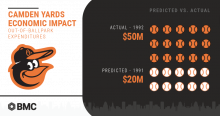Play ball! The Orioles take on the Minnesota Twins this Thursday, March 29, for Opening Day at Camden Yards. With all the excitement of another professional baseball season, we’ve been a bit curious about Camden Yards’ history, so we dug through the Regional Information Center’s archives.The building of Camden Yards Sports Complex was a hot topic right up until they broke ground in 1988. How much money would a brand new ballpark really bring in? Could it ever replace the much-loved Memorial Stadium? Would it attract new sports talent to Baltimore? New fans? This report from 1996 looked at estimates produced by several Maryland departments including the Department of Fiscal Services, the Office of the Governor, and the Baltimore Development Corporation, and then compared them to the actual financial and political impact post-construction. Estimates predicted a 20 percent increase in attendance from the 1991 final season at Memorial Stadium, creating millions of dollars in direct and indirect benefits to the city. Instead, the 1992 Orioles season smashed expectations with a 76 percent increase. Out-of-town visitors flooded in to eat at local restaurants and stay in downtown hotels, boosting revenues from the new stadium even further. Ultimately, visitors came more often and spent more money in Baltimore City. Camden Yards was built as a baseball-only field in order to keep the Orioles franchise interested. After much debate and negotiation, a football stadium was built as part of the Camden Yards Sports Complex in order to attract a football franchise back to Baltimore. Many of the stadium’s supporters used the results of Camden Yards to show how successful the football stadium could be. The Camden Yards ballpark itself became an example of the potential success of future sports projects. The Ravens played their first two years in Baltimore at the old Memorial Stadium before moving to M&T Bank Stadium for the 1998 season. The Baltimore Sun reported in 2017 that during the 2014 and 2015 seasons, spending associated with games averaged $331.3 million and state tax revenue generated approximately $22.5 million. So however you play it, constructing Camden Yards turned out to be a home run for Baltimore!

